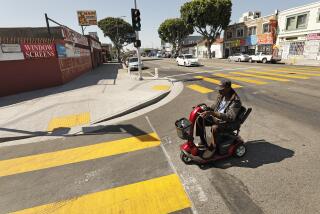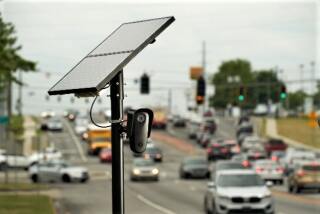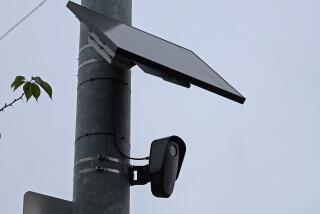High-Tech on the Highway : Freeways: Video cameras are being tested that would catch car-pool-lane violators.
- Share via
It could be the traffic cop of the future.
Throughout the country, from the Washington Beltway to the streets of Pasadena, transportation officials are turning to the camera to crack down on motorists guilty of everything from speeding to running stop lights.
Now the concept could be coming to California in an even bigger way.
Authorities at the California Department of Transportation and the California Highway Patrol are looking at using video cameras to nab motorists who violate car-pool-lane rules on freeways up and down the state.
The new video technology, which features super-slow-motion replay machines and cameras as tiny as a lipstick tube, has already had a dry run on the Artesia and Simi Valley freeways in Los Angeles County and was tested again Thursday in Orange County along the Costa Mesa Freeway’s car-pool lanes.
For the CHP, the idea has particular allure. If the video technique proves feasible, it could help shrink violation rates in car-pool lanes and relieve officers of the dangerous task of pulling scofflaws across three or four lanes of freeway traffic to issue a ticket.
“We’re interested in testing any kind of technique that could help out,” said Lt. Shawn Watts of the CHP’s transportation planning unit in Sacramento. “This looks pretty good because it would possibly save a lot of officer time, reduce their exposure to traffic out there and hopefully catch more violators.”
Transportation officials agree the idea shows promise, but obstacles remain. Technological hurdles must be overcome, and logistical changes might be necessary before tickets could be delivered to motorists via the mail.
And as they have in other parts of the country, some residents and civil liberties groups likely will conjure Orwellian images of “Big Brother,” saying the cameras infringe on the privacy of motorists.
“Speaking for myself, the ‘Big Brother’ aspect of it is a little disturbing,” said Bill Ward, a leader of Drivers for Highway Safety, a small Orange County-based group opposed to car-pool lanes. “I just don’t see this going very far.”
Transportation officials, however, insist the benefits of video traffic enforcement techniques far outweigh the risks.
“I think those kinds of arguments, the ‘Big Brother’ thing, can be overcome and has to be overcome,” said Steve Albert, a Texas-based expert on the use of video cameras for monitoring traffic. “Like every other technological advancement, it will come in time.”
Most authorities in California estimate it could be as long as five years before the video cameras could become a fixture along car-pool lanes in the state. A host of difficulties must first be addressed.
Initial tests, which are being conducted as part of a larger study of car-pool enforcement, have been hampered by the tedious task of positioning cameras just right so they can peer down into a car to spot the less-obvious passenger--a baby on board or someone lying down on the back seat. Tinted windows, sun glare, morning mist on the windshield and other environmental factors also can obscure the camera’s view.
Assuming those sorts of troubles can be ironed out, state authorities would still have to deal with the problem of angry motorists, who might reject the idea of receiving a ticket through the mail. Laws would probably have to be adjusted so the burden of a ticket falls on the owner of a vehicle instead of the driver, a regulation that might irk any parent whose teen-ager got caught by the camera driving solo down the car-pool lane in the family car.
Even the issue of who monitors the cameras and videotape could prove vexing. Though some cities have hired outside firms to pluck violators from the pictures and search the records for vehicle owners, California authorities envision a system that would probably employ sworn peace officers to determine who has broken the law.
Whatever is decided, the concept promises to engender a fair amount of debate. Surveys conducted as part of the car-pool violation study found motorists “equally divided” over camera-patrolled car-pool lanes, according to John Billheimer, vice president of Systan Inc., a Los Altos-based transportation planning firm doing the study for Caltrans.
The concept has been in use for years in other parts of the world. West Germany has had an active “photo-radar” program for about two decades, and the technique is used to nab speeders elsewhere in Europe, Asia and South America.
Photo-radar, which combines still photographs with radar to determine a motorist’s speed, has only recently made an appearance in the United States. Although some residents quickly dubbed it “robocop,” the technique has been used successfully in Paradise Valley, Ariz., since 1987. Pasadena began issuing citations with the same Swiss-made device in June, 1988.
Since then, more than 14,000 speeding tickets have been issued in Pasadena for motorists caught by the photo-radar, said Sgt. Gene Gray of the Pasadena police. Nearly 300 people fought their tickets, but the city prevailed in 90% of those cases, he said.
The concept is being considered for the Washington area. Officials with the Virginia State Police are investigating the use of photo-radar or video cameras to ticket speeders along the 60 miles of freeway circling the capital.
In California, authorities are focusing for now on using such high-tech ploys simply to uphold the law of the car-pool lane. While state officials are quick to emphasize that the concept is still in the testing stages, they have a hard time hiding their optimism.
“As far as the safety issues, I think it could be a great tool,” said Scott McGowen, an assistant transportation engineer with Caltrans in Sacramento. “We’ll have to look into the costs some more, and maintenance of such a system. But this could help with many problems we have now.
More to Read
Sign up for Essential California
The most important California stories and recommendations in your inbox every morning.
You may occasionally receive promotional content from the Los Angeles Times.










